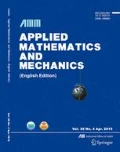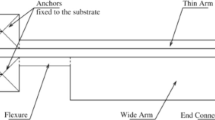Abstract
Thermally responsive liquid crystal elastomers (LCEs) hold great promise in applications of soft robots and actuators because of the induced size and shape change with temperature. Experiments have successfully demonstrated that the LCE based bimorphs can be effective soft robots once integrated with soft sensors and thermal actuators. Here, we present an analytical transient thermo-mechanical model for a bimorph structure based soft robot, which consists of a strip of LCE and a thermal inert polymer actuated by an ultrathin stretchable open-mesh shaped heater to mimic the unique locomotion behaviors of an inchworm. The coupled mechanical and thermal analysis based on the thermo-mechanical theory is carried out to underpin the transient bending behavior, and a systematic understanding is therefore achieved. The key analytical results reveal that the thickness and the modulus ratio of the LCE and the inert polymer layer dominate the transient bending deformation. The analytical results will not only render fundamental understanding of the actuation of bimorph structures, but also facilitate the rational design of soft robotics.
Similar content being viewed by others
References
WEHNER, M., TRUBY, R. L., FITZGERALD, D. J., MOSADEGH, B., WHITESIDES, G. M., LEWIS, J. A., and WOOD, R. J. An integrated design and fabrication strategy for entirely soft, autonomous robots. nature, 536(7617), 451–455 (2016)
BARTLETT, N. W., TOLLEY, M. T., OVERVELDE, J. T. B., WEAVER, J. C., MOSADEGH, B., BERTOLDI, K., WHITESIDES, G. M., and WOOD, R. J. A 3D-printed, functionally graded soft robot powered by combustion. Science, 349(6244), 161–165 (2015)
GISBY, T. A., O’BRIEN, B. M., and ANDERSON, I. A. Self sensing feedback for dielectric elastomer actuators. Applied Physics Letters, 102, 193703 (2013)
LI, T. F., LI, G. R., LIANG, Y. M., CHENG, T. Y., DAI, J., YANG, X. X., LIU, B. Y., ZENG, Z. D., HUANG, Z. L., LUO, Y. W., XIE, T., and YANG, W. Fast-moving soft electronic fish. Science Advances, 3, e1602045 (2017)
KIM, D., KIM, K. J., TAK, Y., PUGAL, D., and PARK, I. Self-oscillating electroactive polymer actuator. Applied Physics Letters, 90, 184104 (2007)
REN, K. L., BORTOLIN, R. S., and ZHANG, Q. M. An investigation of a thermally steerable electroactive polymer/shape memory polymer hybrid actuator. Applied Physics Letters, 108, 062901 (2016)
LASCHI, C., CIANCHETTI, M., MAZZOLAI, B., MARGHERI, L., FOLLADOR, M., and DARIO, P. Soft robot arm inspired by the octopus. Advanced Robotics, 26, 709–727 (2012)
MENG, H. and LI, G. A review of stimuli-responsive shape memory polymer composites. Polymer, 54(9), 2199–2221 (2013)
PALLEAU, E., MORALES, D., DICKEY, M. D., and VELEY, O. D. Reversible patterning and actuation of hydrogels by electrically assisted ionoprinting. Nature Communications, 4(4), 2257 (2013)
MAEDA, S., KATO, T., KOGURE, H., and HOSOYA, N. Rapid response of thermo-sensitive hydrogels with porous structures. Applied Physics Letters, 106, 171909 (2015)
WANG, C. J., SIM, K., CHEN, J., KIM, H., RAO, Z., LI, Y. H., CHEN, W. Q., SONG, J. Z., VERDUZCO, R., and YU, C. J. Soft ultrathin electronics innervated adaptive fully soft robots. Advanced Materials, 30, 1706695 (2018)
LI, M. E., LV, S., and ZHOU, J. X. Photo-thermo-mechanically actuated bending and snapping kinetics of liquid crystal elastomer cantilever. Smart Materials and Structures, 23, 125012 (2014)
AN, N., LI, M. E., and ZHOU, J. X. Instability of liquid crystal elastomer. Smart Materials and Structures, 25, 015016 (2016)
YANG, T. Z., BAI, X., GAO, D. L., WU, L. Z., LI, B. W., THONG, J. T. L., and QIU, C. W. Invisible sensors: simultaneous sensing and camouflaging in multiphysical fields. Advanced Materials, 27(47), 7752–7758 (2015)
BEHL, M., KRATZ, K., NEOCHEL, U., SAUTER, T., and LENDLEIN, A. Temperature-memory polymer actuators. Proceedings of the National Academy of Sciences of the United States of America, 110(31), 12555–12559 (2013)
WHITE, T. J. and BROER, D. J. Programmable and adaptive mechanics with liquid crystal polymer networks and elastomers. Nature Materials, 14(11), 1087–1098 (2015)
HUANG, Y. A., DING, Y. J., BIAN, J., SU, Y. W., ZHOU, J., DUAN, Y. Q., and YIN, Z. P. Hyper-stretchable self-powered sensors based on electrohydrodynamically printed, self-similar piezoelectric nano/microfibers. Nano Energy, 40, 432–439 (2017)
ZHANG, Y. H., FU, H. R., SU, Y. W., XU, S., CHENG, H. Y., FAN, J. A., HWANG, K. C., ROGERS, J. A., and HUANG, Y. G. Mechanics of ultra-stretchable self-similar serpentine interconnects. Acta Materialia, 61, 7816–7827 (2013)
ZHANG, Y. H., HUANG, Y. G., and ROGERS, J. A. Mechanics of stretchable batteries and supercapacitors. Current Opinion in Solid State and Materials Science, 19(3), 190–199 (2015)
MA, Y. J., FENG, X., ROGERS, J. A., HUANG, Y. G., and ZHANG, Y. H. Design and ap-plication of ‘J-shaped’ stress-strain behavior in stretchable electronics: a review. Lab on a Chip, 17(10), 1689–1704 (2017)
CHEN, H., ZHU, F., JANG, K. I., FENG, X., ROGERS, J. A., ZHANG, Y. H., HUANG, Y. G., and MA, Y. J. The equivalent medium of cellular substrate under large stretching, with applications to stretchable electronics. Journal of the Mechanics and Physics of Solids, 120, 199–207 (2018)
LIU, Z. and GAO, J. Deformation-pattern-based digital speckle correlation for coefficient of thermal expansion evaluation of film. Optics Express, 19, 17469–17479 (2011)
SUN, Y. X., MA, J. X., LIU, S. B., and YANG, J. L. Analytical solution of transient heat conduction in a bi-layered circular plate irradiated by laser pulse. Canadian Journal of Physics, 95(4), 322–330 (2017)
CHEN, T. M. and CHEN, C. C. Numerical solution for the hyperbolic heat conduction problems in the radial-spherical coordinate system using a hybrid Green’s function method. International Journal of Thermal Sciences, 49(7), 1193–1196 (2010)
NILISHKOV, J. P. Curvature estimation for multilayer hinged structures with initial strains. Journal of Applied Physics, 94(8), 5333–5336 (2003)
CUI, Y., WANG, C. J., SIM, K., CHEN, J., LI, Y. H., XING, Y. F., YU, C. J., and SONG, J. Z. A simple analytical thermo-mechanical model for liquid crystal elastomer bilayer structures. AIP Advances, 8, 025215 (2018)
YU, C. J., DUAN, Z., YUAN, P. X., LI, Y. H., SU, Y. W., ZHANG, X., PAN, Y. P., DAI, L. L., NUZZO, R. G., HUANG, Y. G., JIANG, H. Q., and ROGERS, J. A. Electronically programmable, reversible shape change in two-and three-dimensional hydrogel structures. Advanced Materials, 25(11), 1541–1546 (2013)
TORRAS, N., ZINOVIEV, K. E., CAMARGO, C. J., CAMPO, E. M., CAMPANELLA, H., ESTEVE, J., MARSGALL, J. E., TERENTJEV, E. M., OMASTOVA, M., and KRUPA, I. Tactile device based on opto-mechanical actuation of liquid crystal elastomers. Sensors and Actuators A: Physical, 208, 104–112 (2014)
DuPont. Kapton® HN general-purpose polyimide film (2018) https://www.dupont.com/products/kapton-hn.html
Author information
Authors and Affiliations
Corresponding authors
Additional information
Project supported by the National Basic Research Program (No. 2015CB351901), the National Nat- ural Science Foundation of China (Nos. 11372272, 11622221, 11621062, 11502009, and 11772030), the Doctoral New Investigator Grant from American Chemical Society Petroleum Research Fund of the National Science Foundation (Nos. 1509763 and 1554499), the Opening Fund of State Key Laboratory for Strength and Vibration of Mechanical Structures, Xi’an Jiaotong University (No. SV2018-KF-13), and the Fundamental Research Funds for the Central Universities (No. 2017XZZX002-11)
Rights and permissions
About this article
Cite this article
Cui, Y., Yin, Y., Wang, C. et al. Transient thermo-mechanical analysis for bimorph soft robot based on thermally responsive liquid crystal elastomers. Appl. Math. Mech.-Engl. Ed. 40, 943–952 (2019). https://doi.org/10.1007/s10483-019-2495-8
Received:
Revised:
Published:
Issue Date:
DOI: https://doi.org/10.1007/s10483-019-2495-8




